

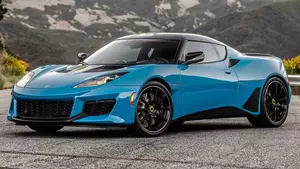
| Engine | 0—60 mph | 0—100 km/h | Top Speed | Averange Economy |
|---|---|---|---|---|
| 3.5 V6 | 3.6 s | 3.8 s | 174 mph | 20 mpg |
| Engine | 3.5 V6 |
|---|---|
| 0—60 mph | 3.6 s |
| 0—100 km/h | 3.8 s |
| Top Speed | 174 mph |
| Averange Economy | 20 mpg |
In 2020 Lotus Evora 0-60 acceleration was 3.6 seconds.
Lotus Evora 0-60 mph was up to 62% faster in 2020 than world's average.
In 2020, Lotus Evora 0-60 mph to car weight ratio is shown below:
| Vehicle | Acceleration 0—60 mph (0—100 km/h) | Maximum speed | Acceleration to passenger ratio | Fuel consumption at high speed | Fuel type / gearbox |
|---|---|---|---|---|---|
| 3.5 V6 | 3.6 s to 60 mph (3.8 s to 100 km/h) | 174 mph (280 km/h) | 1.8 s to 60 mph / person | 24 mpg (9.8 L per 100 km) | Petrol (Gasoline) / 6 |
| Vehicle | 3.5 V6 |
|---|---|
| Acceleration 0-60 mph (0-100 km/h) | 3.6 s to 60 mph (3.8 s to 100 km/h) |
| Maximum speed | 174 mph (280 km/h) |
| Acceleration to passenger ratio | 1.8 s to 60 mph / person |
| Fuel consumption at high speed | 24 mpg (9.8 L per 100 km) |
| Fuel type / gearbox | Petrol (Gasoline) / 6 |
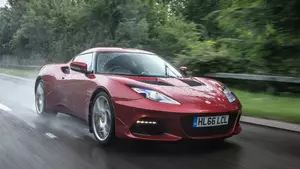
| Engine | 0—60 mph | 0—100 km/h | Top Speed | Averange Economy |
|---|---|---|---|---|
| 3.5 V6 | 4 s | 4.2 s | 173 mph | - |
| Engine | 3.5 V6 |
|---|---|
| 0—60 mph | 4 s |
| 0—100 km/h | 4.2 s |
| Top Speed | 173 mph |
| Averange Economy | - |
In 2020 Lotus Evora 0-60 acceleration was 4 seconds.
Lotus Evora 0-60 mph was up to 58% faster in 2020 than world's average.
In 2020, Lotus Evora 0-60 mph to car weight ratio is shown below:
| Vehicle | Acceleration 0—60 mph (0—100 km/h) | Maximum speed | Acceleration to passenger ratio | Fuel consumption at high speed | Fuel type / gearbox |
|---|---|---|---|---|---|
| 3.5 V6 | 4 s to 60 mph (4.2 s to 100 km/h) | 173 mph (278 km/h) | 2 s to 60 mph / person | - | Petrol (Gasoline) / 6 |
| Vehicle | 3.5 V6 |
|---|---|
| Acceleration 0-60 mph (0-100 km/h) | 4 s to 60 mph (4.2 s to 100 km/h) |
| Maximum speed | 173 mph (278 km/h) |
| Acceleration to passenger ratio | 2 s to 60 mph / person |
| Fuel consumption at high speed | - |
| Fuel type / gearbox | Petrol (Gasoline) / 6 |
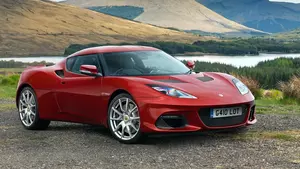
| Engine | 0—60 mph | 0—100 km/h | Top Speed | Averange Economy |
|---|---|---|---|---|
| 3.5 V6 | 3.9 s | 4.1 s | 174 mph | - |
| Engine | 3.5 V6 |
|---|---|
| 0—60 mph | 3.9 s |
| 0—100 km/h | 4.1 s |
| Top Speed | 174 mph |
| Averange Economy | - |
In 2020 Lotus Evora 0-60 acceleration was 3.9 seconds.
Lotus Evora 0-60 mph was up to 59% faster in 2020 than world's average.
In 2020, Lotus Evora 0-60 mph to car weight ratio is shown below:
| Vehicle | Acceleration 0—60 mph (0—100 km/h) | Maximum speed | Acceleration to passenger ratio | Fuel consumption at high speed | Fuel type / gearbox |
|---|---|---|---|---|---|
| 3.5 V6 | 3.9 s to 60 mph (4.1 s to 100 km/h) | 174 mph (280 km/h) | 2 s to 60 mph / person | - | Petrol (Gasoline) / 6 |
| Vehicle | 3.5 V6 |
|---|---|
| Acceleration 0-60 mph (0-100 km/h) | 3.9 s to 60 mph (4.1 s to 100 km/h) |
| Maximum speed | 174 mph (280 km/h) |
| Acceleration to passenger ratio | 2 s to 60 mph / person |
| Fuel consumption at high speed | - |
| Fuel type / gearbox | Petrol (Gasoline) / 6 |
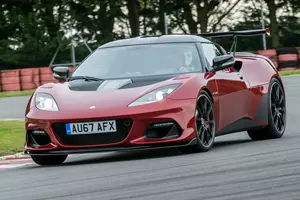
| Engine | 0—60 mph | 0—100 km/h | Top Speed | Averange Economy |
|---|---|---|---|---|
| 3.5 V6 24V | 3.5 s | 3.7 s | 174 mph | - |
| Sport 3.5 V6 24V | 3.6 s | 3.8 s | 196 mph | - |
| Engine | 3.5 V6 24V |
|---|---|
| 0—60 mph | 3.5 s |
| 0—100 km/h | 3.7 s |
| Top Speed | 174 mph |
| Averange Economy | - |
| Engine | Sport 3.5 V6 24V |
| 0—60 mph | 3.6 s |
| 0—100 km/h | 3.8 s |
| Top Speed | 196 mph |
| Averange Economy | - |
In 2017, Lotus Evora 0-60 acceleration was between 3.5 and 3.6 seconds.
Lotus Evora 0-60 mph was up to 63% faster in 2017 than world's average.
In 2017, Lotus Evora 0-60 mph to car weight ratio is shown below:
| Vehicle | Acceleration 0—60 mph (0—100 km/h) | Maximum speed | Acceleration to passenger ratio | Fuel consumption at high speed | Fuel type / gearbox |
|---|---|---|---|---|---|
| 3.5 V6 24V | 3.5 s to 60 mph (3.7 s to 100 km/h) | 174 mph (280 km/h) | 1.8 s to 60 mph / person | - | Petrol (Gasoline) / 6 |
| Sport 3.5 V6 24V | 3.6 s to 60 mph (3.8 s to 100 km/h) | 196 mph (315 km/h) | 1.8 s to 60 mph / person | - | Petrol (Gasoline) |
| Vehicle | 3.5 V6 24V |
|---|---|
| Acceleration 0-60 mph (0-100 km/h) | 3.5 s to 60 mph (3.7 s to 100 km/h) |
| Maximum speed | 174 mph (280 km/h) |
| Acceleration to passenger ratio | 1.8 s to 60 mph / person |
| Fuel consumption at high speed | - |
| Fuel type / gearbox | Petrol (Gasoline) / 6 |
| Vehicle | Sport 3.5 V6 24V |
| Acceleration 0-60 mph (0-100 km/h) | 3.6 s to 60 mph (3.8 s to 100 km/h) |
| Maximum speed | 196 mph (315 km/h) |
| Acceleration to passenger ratio | 1.8 s to 60 mph / person |
| Fuel consumption at high speed | - |
| Fuel type / gearbox | Petrol (Gasoline) |
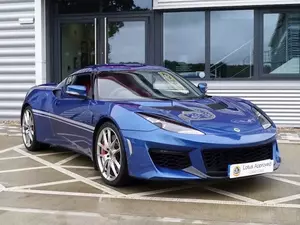
| Engine | 0—60 mph | 0—100 km/h | Top Speed | Averange Economy |
|---|---|---|---|---|
| 3.5 V6 | 3.9 s | 4.1 s | 174 mph | 24 mpg |
| Engine | 3.5 V6 |
|---|---|
| 0—60 mph | 3.9 s |
| 0—100 km/h | 4.1 s |
| Top Speed | 174 mph |
| Averange Economy | 24 mpg |
In 2016 Lotus Evora 0-60 acceleration was 3.9 seconds.
Lotus Evora 0-60 mph was up to 59% faster in 2016 than world's average.
In 2016, Lotus Evora 0-60 mph to car weight ratio is shown below:
| Vehicle | Acceleration 0—60 mph (0—100 km/h) | Maximum speed | Acceleration to passenger ratio | Fuel consumption at high speed | Fuel type / gearbox |
|---|---|---|---|---|---|
| 3.5 V6 | 3.9 s to 60 mph (4.1 s to 100 km/h) | 174 mph (280 km/h) | 2 s to 60 mph / person | 33 mpg (7.1 L per 100 km) | Petrol (Gasoline) / 6 |
| Vehicle | 3.5 V6 |
|---|---|
| Acceleration 0-60 mph (0-100 km/h) | 3.9 s to 60 mph (4.1 s to 100 km/h) |
| Maximum speed | 174 mph (280 km/h) |
| Acceleration to passenger ratio | 2 s to 60 mph / person |
| Fuel consumption at high speed | 33 mpg (7.1 L per 100 km) |
| Fuel type / gearbox | Petrol (Gasoline) / 6 |
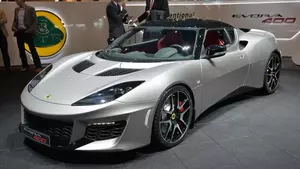
| Engine | 0—60 mph | 0—100 km/h | Top Speed | Averange Economy |
|---|---|---|---|---|
| 3.5 V6 | 4 s | 4.2 s | 0 mph | - |
| Engine | 3.5 V6 |
|---|---|
| 0—60 mph | 4 s |
| 0—100 km/h | 4.2 s |
| Top Speed | 0 mph |
| Averange Economy | - |
In 2015 Lotus Evora 0-60 acceleration was 4 seconds.
Lotus Evora 0-60 mph was up to 58% faster in 2015 than world's average.
In 2015, Lotus Evora 0-60 mph to car weight ratio is shown below:
| Vehicle | Acceleration 0—60 mph (0—100 km/h) | Maximum speed | Acceleration to passenger ratio | Fuel consumption at high speed | Fuel type / gearbox |
|---|---|---|---|---|---|
| 3.5 V6 | 4 s to 60 mph (4.2 s to 100 km/h) | 0 mph (0 km/h) | 2 s to 60 mph / person | - | Petrol (Gasoline) / 6 |
| Vehicle | 3.5 V6 |
|---|---|
| Acceleration 0-60 mph (0-100 km/h) | 4 s to 60 mph (4.2 s to 100 km/h) |
| Maximum speed | 0 mph (0 km/h) |
| Acceleration to passenger ratio | 2 s to 60 mph / person |
| Fuel consumption at high speed | - |
| Fuel type / gearbox | Petrol (Gasoline) / 6 |
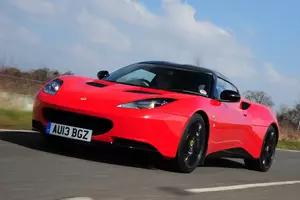
| Engine | 0—60 mph | 0—100 km/h | Top Speed | Averange Economy |
|---|---|---|---|---|
| 3.5 V6 | 4.4 s | 4.6 s | 178 mph | 24 mpg |
| Engine | 3.5 V6 |
|---|---|
| 0—60 mph | 4.4 s |
| 0—100 km/h | 4.6 s |
| Top Speed | 178 mph |
| Averange Economy | 24 mpg |
In 2013 Lotus Evora 0-60 acceleration was 4.4 seconds.
Lotus Evora 0-60 mph was up to 54% faster in 2013 than world's average.
In 2013, Lotus Evora 0-60 mph to car weight ratio is shown below:
| Vehicle | Acceleration 0—60 mph (0—100 km/h) | Maximum speed | Acceleration to passenger ratio | Fuel consumption at high speed | Fuel type / gearbox |
|---|---|---|---|---|---|
| 3.5 V6 | 4.4 s to 60 mph (4.6 s to 100 km/h) | 178 mph (286 km/h) | 2.2 s to 60 mph / person | 32 mpg (7.4 L per 100 km) | Petrol (Gasoline) |
| Vehicle | 3.5 V6 |
|---|---|
| Acceleration 0-60 mph (0-100 km/h) | 4.4 s to 60 mph (4.6 s to 100 km/h) |
| Maximum speed | 178 mph (286 km/h) |
| Acceleration to passenger ratio | 2.2 s to 60 mph / person |
| Fuel consumption at high speed | 32 mpg (7.4 L per 100 km) |
| Fuel type / gearbox | Petrol (Gasoline) |
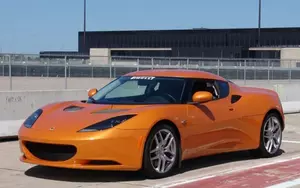
| Engine | 0—60 mph | 0—100 km/h | Top Speed | Averange Economy |
|---|---|---|---|---|
| 3.5 V6 | 4.5 s | 4.7 s | 167 mph | 24 mpg |
| Engine | 3.5 V6 |
|---|---|
| 0—60 mph | 4.5 s |
| 0—100 km/h | 4.7 s |
| Top Speed | 167 mph |
| Averange Economy | 24 mpg |
In 2012 Lotus Evora 0-60 acceleration was 4.5 seconds.
Lotus Evora 0-60 mph was up to 53% faster in 2012 than world's average.
In 2012, Lotus Evora 0-60 mph to car weight ratio is shown below:
| Vehicle | Acceleration 0—60 mph (0—100 km/h) | Maximum speed | Acceleration to passenger ratio | Fuel consumption at high speed | Fuel type / gearbox |
|---|---|---|---|---|---|
| 3.5 V6 | 4.5 s to 60 mph (4.7 s to 100 km/h) | 167 mph (269 km/h) | 2.3 s to 60 mph / person | 34 mpg (6.9 L per 100 km) | Petrol (Gasoline) / 6 |
| Vehicle | 3.5 V6 |
|---|---|
| Acceleration 0-60 mph (0-100 km/h) | 4.5 s to 60 mph (4.7 s to 100 km/h) |
| Maximum speed | 167 mph (269 km/h) |
| Acceleration to passenger ratio | 2.3 s to 60 mph / person |
| Fuel consumption at high speed | 34 mpg (6.9 L per 100 km) |
| Fuel type / gearbox | Petrol (Gasoline) / 6 |
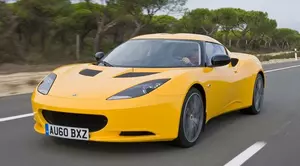
| Engine | 0—60 mph | 0—100 km/h | Top Speed | Averange Economy |
|---|---|---|---|---|
| 3.5 V6 | 4.7 s | 4.9 s | 162 mph | 27 mpg |
| Engine | 3.5 V6 |
|---|---|
| 0—60 mph | 4.7 s |
| 0—100 km/h | 4.9 s |
| Top Speed | 162 mph |
| Averange Economy | 27 mpg |
In 2010 Lotus Evora 0-60 acceleration was 4.7 seconds.
Lotus Evora 0-60 mph was up to 51% faster in 2010 than world's average.
In 2010, Lotus Evora 0-60 mph to car weight ratio is shown below:
| Vehicle | Acceleration 0—60 mph (0—100 km/h) | Maximum speed | Acceleration to passenger ratio | Fuel consumption at high speed | Fuel type / gearbox |
|---|---|---|---|---|---|
| 3.5 V6 | 4.7 s to 60 mph (4.9 s to 100 km/h) | 162 mph (261 km/h) | 2.4 s to 60 mph / person | 36 mpg (6.5 L per 100 km) | Petrol (Gasoline) |
| Vehicle | 3.5 V6 |
|---|---|
| Acceleration 0-60 mph (0-100 km/h) | 4.7 s to 60 mph (4.9 s to 100 km/h) |
| Maximum speed | 162 mph (261 km/h) |
| Acceleration to passenger ratio | 2.4 s to 60 mph / person |
| Fuel consumption at high speed | 36 mpg (6.5 L per 100 km) |
| Fuel type / gearbox | Petrol (Gasoline) |